
Chapter 5
74
Edge-to-Edge Measurement
Use edge-to-edge measurement mode if you want to measure the time interval between a
specified start edge and a specified stop edge.
The start edge can occur on the rising edge or the falling edge of the Counter 0 Gate signal,
and the stop edge can occur on the rising edge or the falling edge of the Counter 0 Gate signal.
When the start edge is detected, the counter/timer starts incrementing and continues
incrementing until the stop edge is detected. The C/T then stops incrementing until it is
enabled to start another measurement. When the operation is complete, you can read the
value of the counter. You can count a maximum of 4,294,967,296 events before the counter rolls
over to 0 and starts counting again.
You can use edge-to-edge measurement to measure the following characteristics of a signal:
• Pulse width
– The amount of time that a signal pulse is in a high or a low state, or the
amount of time between a rising edge and a falling edge or between a falling edge and a
rising edge. You can calculate the pulse width as follows:
Pulse width = Number of counts/24 MHz
• Period
– The time between two occurrences of the same edge (rising edge to rising edge,
or falling edge to falling edge). You can calculate the period as follows:
Period = 1/Frequency
Period = Number of counts/24 MHz
• Frequency – The number of periods per second. You can calculate the frequency as
follows:
Frequency = 24 MHz/Number of Counts
Using software, specify the counter/timer mode as measure, the C/T clock source as internal,
the start edge as rising or falling gate, and the stop edge as rising or falling gate.
Make sure that the signals are wired appropriately. Refer to
for an example of connecting an edge-to-edge measurement application.
Rate Generation
Use rate generation mode to generate a continuous pulse output signal from Counter 0 Out;
this mode is sometimes referred to as continuous pulse output or pulse train output.
The pulse output operation is enabled whenever the Counter 0 Gate signal is active (high
level, low level, or software gate). While the pulse output operation is enabled, the counter
outputs a high-to-low going pulse with a pulse width of 50% continuously. As soon as the
operation is disabled, rate generation stops.
The frequency of the output is determined by the C/T clock source (either internal or external)
and the clock divider used. You can generate an output signal from Counter 0 Out with a
frequency of 15 Hz to 12 MHz.
Summary of Contents for DT9812 Series
Page 1: ...DT9812 UM 20769 R DT9813 and User s Manual DT9814 Series Title Page ...
Page 4: ......
Page 12: ...About this Manual 12 ...
Page 13: ...13 1 Overview Key Hardware Features 14 Supported Software 15 Getting Started Procedure 16 ...
Page 17: ...Part 1 Getting Started ...
Page 18: ......
Page 26: ...Chapter 2 26 ...
Page 53: ...Part 2 Using Your Module ...
Page 54: ......
Page 76: ...Chapter 5 76 ...
Page 88: ...Chapter 6 88 ...
Page 94: ...Chapter 7 94 ...
Page 113: ...113 B Screw Terminal and Connector Pin Assignments ...
















































